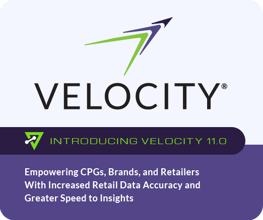Table of Contents
While some consumer packaged goods (CPG) companies may be drowning in supply chain disruptions, inflation issues, and/or workforce challenges, many more—if not most—are drowning in data.
Today, a tsunami of information pours in from a myriad of sources, and CPGs are trying to stay afloat as they work to determine what retail sales data is most useful for critical decision-making, how much data they need to collect and how often, and how to effectively analyze and interpret that data to generate meaningful and actionable insights that will help accelerate their growth.
The bigger question becomes: How much data is too much? The answer is that you have too much data when it’s not the right data or you aren’t getting the necessary value from it—leaving you and your company to tread water in your decision-making.
NOT ALL RETAIL SALES DATA IS CREATED EQUALLY
So, which type of data is most valuable—Syndicated Store or Retailer Direct Store?
In short, syndicated store data is an aggregation of retail sales activity that spans multiple retailers and provides more of an overview and static industry, geographic market, product category, or channel perspective. The data is collected by third-party syndicated data companies, and brands purchase this data to perform competitive analyses and understand industry or sales trends to better determine how to reach consumers.
The data includes only sales data from retail chains that cooperate with the data providers, and their syndicated databases use standard category and brand definitions—which may or may not make sense for your company or brand. Therefore, the data provided is general in nature, provides broad insights, and does not feature individual retailers.
Retail direct store data or store-specific data is retail point-of-sale (POS) data that comes directly from individual retailers and store locations. The data can be collected and provided in near real time (i.e., daily) for individual products or items/SKUs at a store level.
Because this direct data is most granular and can include all retailers and their store locations, it does not rely on statistical projections to account for missing chains and retailers, thereby providing CPGs with a holistic view of retail sales activity. Thus, it drives the most timely and accurate retail data reporting, analytics, and insights to enable fast, collaborative decision-making across the enterprise and with retailer partners.
In general, think of it this way: Syndicated data explains what’s happening while retail direct store data will tell you why it’s happening.
A DEEPER DIVE into the data
Let’s take a more in-depth look between the two data types to help you decide which is most valuable to you and your company.
| SYNDICATED STORE DATA | RETAILER DIRECT STORE DATA |
| Time-Consuming and Outdated It takes significant time—a minimum of two weeks and more often than not, a month—for data providers to collect, compile, and share broad market data. This makes the data much less useful, especially for fast-moving categories. And for CPGs that use multiple sources of syndicated data, compiling and reviewing the information is even more time-consuming, difficult, and often manual. Analysts must sift through the information to glean insights, and usually, by the time the information is processed, it’s too late to have optimal value. Time lost equals money lost. |
Expeditious and Timely With data—and data-driven decision-making—timing is everything. Item-level sales data by store can be automatically collected, extracted, and updated daily through retailer data feeds and data adaptors. CPGs can access near real-time information via data visualization tools or feed other decision support applications, leveraging granular insights at their fingertips to make quick, more-informed decisions that increase sales, revenue, profitability, and market share—ushering in a higher ROI. |
|
Gap-filled and Unharmonized If you’re only using one data provider, you still have a problem. Each data provider pays for exclusive access to a retailer’s data. That means if the data provider you’re using doesn’t collect data from a retailer you want, then you don’t have all the information you need to make well-informed decisions, and you’ll need to make some assumptions. Whether you use one or multiple syndicated data providers, you’ll lack “shelf intelligence” and the data granularity and accuracy needed for ongoing analysis, targeting effective changes at the store level, and gaining a competitive advantage. |
Gapless and Harmonized An added advantage of collecting retailer direct store data is that you also can collect inventory and supply chain information to have a clearer view of factory-to-shelf consumption, help identify and reduce out-of-stocks, and improve on-shelf availability. No matter the volume of demand data, it can be cleansed, harmonized, normalized and integrated with internal, ERP, and third-party data quickly using retail data analytics software and a Demand Signal Repository. With no data silos, all data will be unified and accurate and can be shared confidently with all departments for efficient data analysis and collaborative decision-making. |
|
Limits Trade Promotion Success Without timely and accurate daily POS data at a store level to pinpoint what affected sales positively or negatively, you won’t be able to develop effective future trade promotion strategies and marketing initiatives. |
Enhances Trade Promotion Success By accurately identifying root causes for success or failure, CPGs don’t have to guess what strategies are working and which are not—and, more importantly, why. |
|
Tougher, Less-effective Decision-Making Knowledge is power, and without the right data and complete data, CPGs lose control over decision-making that should drive profitable growth for both them and their retail partners. Good data should produce good business decisions—but it won’t produce great ones that positively impact your business. |
Easier, More-effective Decision-Making Eliminating data silos and integrating all demand and supply data provides one version of the truth that all departments can access and leverage daily to make crucial decisions that affect sales, supply chain, operations, and retailer relationships. With retailer direct store data, CPGs can make decisions at a micro level and fine tune store-related activity to gain valuable shelf space, increase product turns, and gain market share. |
|
More Difficult Demand Forecasting and Planning Successful demand forecasting and planning are dependent on data—precise data—that informs the most logical, efficient, and profitable business decisions. If you have only half the picture, you’ll probably achieve half the results for which you were aiming. |
Easier Demand Forecasting and Planning You can’t properly plan for the future if you don’t have the right data. Store-specific data, collected and reviewed daily, enables you to adapt more intelligently and quickly to changing market conditions or supply chain disruptions. Having the capability to monitor near real-time sales activity by product and store location allows CPGs to adjust demand forecasts and plans when necessary. |
So, we’ll ask you again—between syndicated store data and retailer direct store data, which is more valuable to you when it comes to critical decision-making and profitably growing your business?
Before you answer, though, consider the following:
- Do you need near real-time visibility (i.e., daily visibility) into retail sales and inventory levels by item and store, or are you fine with aggregated weekly or monthly sales data at a market, chain, or product category level?
- Do you want sales data on ALL your product sales at ALL retailers to gain a competitive edge, or do you want syndicated data that’s available for any company to purchase and offers no exclusivity?
- Do you want the ability to make immediate, game-changing decisions that will drive increased sales, trade promotion effectiveness, and ROI?
- Do you want to spend more time wrangling and trying to decipher outdated, incomplete, and disparate data or spend time leveraging granular insights based off timely, accurate, and harmonized data?
The two types of data are closely related, but your answers depend on what your desired outcome is for you and your company. However, if your goal is to make the most educated decisions based on the best data available and you had to pick only one dataset to achieve that goal, then we recommend you go with retailer direct store data.
Leveraging the most timely and detailed data is paramount to successfully meeting consumer demand—now and in the future. But, if your goal is to be only “in the ballpark” of your expected sales and you’re not that interested in ongoing growth and gaining market share, then syndicated data should be fine.
SWIM WITH A BUDDY
Although direct store data will provide more granular and precise data, CPGs would be wise to combine knowledge from each data source (if budgets and resources allow) to help increase sales and consumer satisfaction. Utilizing both store-specific data and syndicated data can provide CPGs with robust information to:
- Identify consumer trends and patterns and meet changing consumer expectations
- Capitalize on sales and growth opportunities
- Gain a competitive advantage at the local and regional levels
- Effectively adjust pricing and promotional strategies to ensure successful trade promotions and marketing campaigns
- Improve retailer relationships and secure optimal shelf space
Let’s face it: The retail landscape isn’t going to get any easier or smoother any time soon. And if a CPG is not equipped to ride the waves of reduced product supply, delayed shipments, workforce reduction, rapidly shifting consumer needs and expectations, and more, then it’s going to have a hard time keeping its head—and profits—above water.
If you want to stop treading water in a sea of less-than-optimal retail sales data and decision-making and learn how you can successfully reach the shore of profitable growth, reach out to us now.




